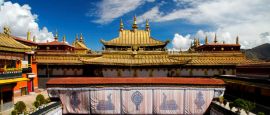Tibet Food and Drink
Tibet’s harsh mountain environment has led to a fairly simple cuisine. The staple foods for most Tibetans are dumplings and noodles, with a big meal out extending to fried yak dishes. Chinese restaurants are omnipresent and mostly offer spicy Szechuanese dishes or pork-free Muslim food from Gansu province. Backpacker-friendly restaurants in the main towns offer variants of western cuisine, from yakburgers to yak cheesecake.
Momos: Dumplings, steamed or sometimes fried, and filled with pockets of ground vegetables or yak meat. The classic Himalayan dish.
Thukba: Thick noodle soup, one of several variants on noodle stew – depending on the shape of the noodles you may also find ‘thanthuk’and ‘hipthuk’.
Bö cha: Yak butter tea, the quintessential Tibetan drink. Tea leaves, boiling water, yak butter, salt and soda are churned up in a long tube to create a greasy, soupy consistency.
Shrabtra: Stir fired meat with celery, carrots and green chilli.
Gyurma: Sausage of yak or sheep’s bood and roasted barley flour or rice.
SokhamBexe: Fried dough with butter and minced meat – said to be a favourite of the Dalai Lama.
Tsampa: Ground roasted barley is a staple in rural or nomad areas, often mixed with butter tea to make a filling gruel. Add sugar and milk or yoghurt for breakfast.
ShaPhaley: Bread stuffed with seasoned beef and cabbage.
Balepkorkun: Flatbread cooked on a skillet.
Lunggoikatsa: Stewed sheep’s head with curry and fennel.
Gundain: Pastry made with barley grain and yeast, roasted flour, dry curd cheese, wild ginseng and brown sugar.
Do you have any Feedback about this page?
© 2026 Columbus Travel Media Ltd. All rights reserved. No part of this site may be reproduced without our written permission, click here for information on Columbus Content Solutions.




 You know where
You know where